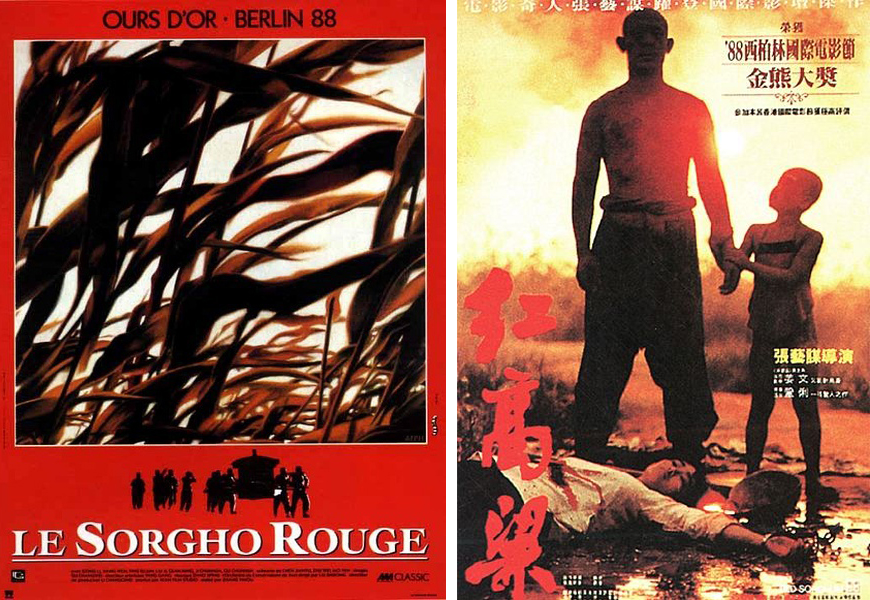Experts explore paradigm shifts in Chinese literary theory

These are posters of Red Sorghum, a 1988 Chinese film about a young woman's life working on a distillery for sorghum liquor. The movie is based on the novel Red Sorghum Clan, a root-seeking literary work by Nobel laureate Mo Yan. Photo: FILE
Experts shed light on the paradigm shifts of Chinese literature and literary theory over the past four decades of reform and opening up.
Chinese literary theory has undergone three turns over the past four decades, said Gao Jianping, a research fellow from the Institute of Literature at the Chinese Academy of Social Sciences. The debate in the field of literature played an important role in emancipating thinking during the early stage of reform and opening up. It liberalized people’s minds and broadened their view.
The second turn happened at the turn of the 21st century, Gao said. In light of economic globalization, China has deepened exchanges with the rest of the world on aesthetics and literature.
As the country has entered a new era of Socialism with Chinese Characteristics, it is necessary to establish a new discourse system of Chinese literary theory, which is the third turn, Gao observed.
At the beginning of reform and opening up, people emphasized the aesthetic features and artistic laws that make literature what it is. This phase can be described as the “inward turn” of literary theory, said Yao Wenfang, a professor from the College of Chinese Language and Literature at Yangzhou University. The “research methodology fever” that emerged in the mid-1980s was a new paradigm introduced to the natural sciences, humanities and social sciences, which promoted the development of literary theory.
From the early 1990s to the beginning of the 21st century, cultural studies paid more attention to society, history, reality and politics, and it pushed literary and art theory to “turn outward,” Yao said.
The 1980s saw the root-seeking fever, culture fever and research methodology fever. In the 1990s there was the rewriting of literary history, the wave of popular culture and the discussion of the modern transformation of ancient Chinese literary theory. The 21st century brought cultural studies and speculation on the aesthetic ideology, localness and globalness of literature. Through these trends one can trace the continual search for rational academic discourse and the construction of a Chinese literary theory system, said Li Fengliang, director of the Institute for Cultural Industries at Shenzhen University.
“Chinese literary theory developed later than that of the West, but it has accelerated over the past four decades of evolution.” Yao said. On the one hand, many theoretical issues are often activated by Western literary theory; on the other hand, the exchange of Western literary theory with Chinese literary theory will stimulate a strong theoretical vitality.
It is necessary to learn from, absorb, reflect on and criticize Western literary theories and to promote the integration and complementarity of Chinese and foreign literary theories. This may become an important growth point in the study of Chinese literary theory for a long time now and in the future, Yao concluded.
Gao suggested following the path of importation, examination and self-innovation. Some people who specialize in introducing foreign literary studies can of course choose to only import, but that is not satisfactory. The next step in research is to test the imported literary theories and select what to absorb in practice. The next step is independent innovation, which is to say creating theories suitable for Chinese literary studies based on practice, Gao suggested.
Following the trajectory, Chinese literary theory has made new developments in recent years. Various changes in literary theory at the turn of the century have prepared conditions for the construction of new literary theories, Gao said, adding that the construction of the Chinese discourse system has been highlighted.
The current research on literary theory has failed to keep up with the rapidly changing cultural reality, and the teaching of literary theory cannot adapt to the cultural experience of students, Li said. The construction of literary theory in the new era requires adherence to reality, a problem-oriented mindset, interdisciplinarity and innovative methods; it must acknowledge the drastic changes in cultural production, communication and consumption patterns.
(edited by JIANG HONG)
